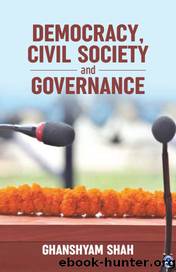Democracy, Civil Society and Governance by Shah Ghanshyam;

Author:Shah, Ghanshyam;
Language: eng
Format: epub
Publisher: SAGE Publications
Published: 2019-11-12T20:25:16.737501+00:00
Street Vendors: Assertion for Public Space
Since 1971, SEWA has been engaged in organizing vendors for their right to a business that can sustain them. Vendors constitute the single-largest group of self-employed workers in urban areas. They sell all kinds of things: vegetables, fruits, fish, used and new garments, utensils, etc. They sell their goods on the side of the roads, on footpaths and street corners, which sometimes obstructs traffic. The municipality considers this use of public space illegal, and the police, who extort substantial bribes from vendors for allowing them to occupy these spaces, are asked to remove them. Since the early 1970s, with the support from SEWA, their demand is that they should be allowed to use roadsides or be provided a space where they could carry on with their business, and that their businesses have a license so that the police would not harass them. This was around the time when Mumbai's slum dwellers were forced to evacuate footpaths, and social activists were demanding the slum dwellers' right to a life. A PIL was filed in the Supreme Court against their eviction in Bombay. In 1978, SEWA organized a protest march in Ahmedabad against police harassment of the vendors in which about 2,000 vendors participated. The organizers invited the chief minister to address their demands. The first question the CM asked the vendors was why they did not go back to the villages whence they had come (Rose 1992, 69). Later, however, he met with the city superintendent of police and municipal officers asking them to meet SEWA's demands for a designated space for the vendors to conduct their business. Police harassment then declined for a while, thanks to the CM's intervention.
In 1980, the authorities marked the open spaces used by vendors as a parking space. SEWA protested the decision, complaining to the police commissioner about it. The vendors carried on regardless, only to have the police come and evict them. This exercise was repeated every day for a week, during which time the vendors lost out on a significant portion of their earnings. SEWA tried to convince the police commissioner not to evict the vendors on humanitarian grounds. Elaben Bhatt argued: âDon't these vendors in their bright clothes with their fresh vegetables look much nicer than parked cars?â¦. Shouldn't we give priority to their earning their living? All they are asking from you is two baskets worth of spaceâ (Rose 1992, 71). Though the commissioner relented and promised to find a way out, nothing happened, and the vendors were again removed the next day. A second week passed. Elaben asked the vendors, âShall we brave the police? Are you ready to claim what is yours?â Everyone agreed that it was better to fight than to starve, and they decided to launch a satyagraha on 30 January, Gandhi's death anniversary. Several leaders, including the chairperson and secretary of the TLA, tried to dissuade them from direct action, but it was futile, and the vendors remained firm and occupied their usual space on the 30.
Download
This site does not store any files on its server. We only index and link to content provided by other sites. Please contact the content providers to delete copyright contents if any and email us, we'll remove relevant links or contents immediately.
| Elections & Political Process | Ideologies & Doctrines |
| International & World Politics | Political Science |
| Public Affairs & Policy | Specific Topics |
| United States |
The Secret History by Donna Tartt(18223)
The Social Justice Warrior Handbook by Lisa De Pasquale(11961)
Thirteen Reasons Why by Jay Asher(8471)
This Is How You Lose Her by Junot Diaz(6461)
Weapons of Math Destruction by Cathy O'Neil(5853)
Zero to One by Peter Thiel(5507)
Beartown by Fredrik Backman(5372)
The Myth of the Strong Leader by Archie Brown(5249)
The Fire Next Time by James Baldwin(5032)
How Democracies Die by Steven Levitsky & Daniel Ziblatt(4970)
Promise Me, Dad by Joe Biden(4916)
Stone's Rules by Roger Stone(4872)
100 Deadly Skills by Clint Emerson(4700)
A Higher Loyalty: Truth, Lies, and Leadership by James Comey(4565)
Rise and Kill First by Ronen Bergman(4553)
Secrecy World by Jake Bernstein(4406)
The David Icke Guide to the Global Conspiracy (and how to end it) by David Icke(4393)
The Farm by Tom Rob Smith(4332)
The Doomsday Machine by Daniel Ellsberg(4253)
